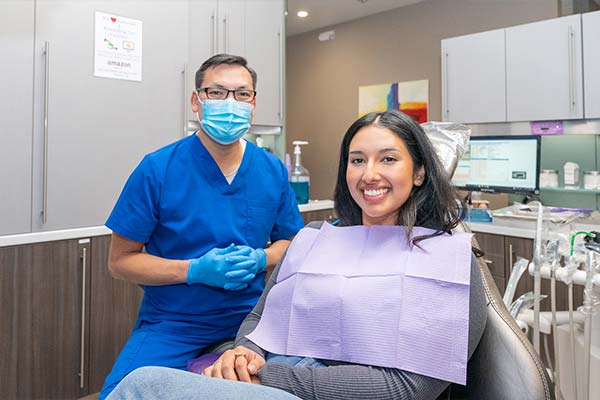Restorative Dentistry
Temecula CA
Restorative Dentistry provided by Dr. Vinh Le and Dr. Quang Le in Temecula, CA at Picasso Dental Care
 While preventative dentistry aims to stop symptoms from progressing into full-blown oral health concerns, the method is not full proof, and even the best, most attentive people can still develop oral health issues. The purpose of restorative dentistry is to correct any issues in your oral health and restore it to normal as quickly and efficiently as possible while providing maximum comfort and as few interruptions to your life as possible. The dedicated professionals at Picasso Dental Care are committed to providing you the utmost quality of care and have experience in administering all kinds of restorative dentistry treatments.
While preventative dentistry aims to stop symptoms from progressing into full-blown oral health concerns, the method is not full proof, and even the best, most attentive people can still develop oral health issues. The purpose of restorative dentistry is to correct any issues in your oral health and restore it to normal as quickly and efficiently as possible while providing maximum comfort and as few interruptions to your life as possible. The dedicated professionals at Picasso Dental Care are committed to providing you the utmost quality of care and have experience in administering all kinds of restorative dentistry treatments. Dental Filling
When a tooth has a great deal of decay, the hole that forms in the enamel needs to be filled so the decay does not continue through the center part of the tooth. If the decay gets too far, and the tooth is damaged too severely it will have to be removed.
The two different types of fillings are amalgam and tooth-colored fillings. An amalgam filling is silver-colored and is typically used at the back of the mouth where they are not readily visible. The composite resin filling can be used anywhere in the mouth. Made of extremely durable material, they can be tinted to perfectly match the coloring of the patient's remaining teeth.
Dental Crown
These are typically chosen to treat extensive decay, tooth defects, damage to the tooth structure or following a root canal. There are two types of crowns that we use.
The first is known as a preformed crown, and the second is a custom fabricated crown. With a preformed crown they are made with stainless steel and can be covered with a veneer to make them look like the rest of your natural teeth. The decision for the veneer is usually dependent upon the location of the tooth. These are more widely used on primary teeth as opposed to adult teeth.
The second type of crown is the custom-fabricated crown. These are also made of metal but are covered with porcelain, so they have a better aesthetic appearance. These are used on permanent teeth which have come in fully.

Crown Lengthening
Those patients with what are called a gummy smile have the majority of their teeth covered by excessive gum tissue. It makes their teeth appear overly small when compared to the relative size of their mouths. While it appears as if they have short teeth, they, in fact, do not. The entire size of their teeth is simply not known due to the tissue covering them. By having crown lengthening, this excessive gum tissue will be removed to show more of the teeth and to improve the overall appearance of their smile.
Dental Bridge
Complete fixed bridges are full arch restorations of teeth made from porcelain that are supported by implants and abutments. One of the most popular materials from which complete fixed bridges are made of is porcelain due to its high malleability and color.
The complete fixed bridge is an easy, comfortable way to maintain your smile after tooth loss. Since it is fixed by dental implants, with the proper hygiene, the bridge may last over a decade.
Dental Implants
A dental implant is a cutting-edge solution for replacing missing teeth. It involves a sturdy titanium post that acts as a root replacement, which is surgically embedded into the jawbone. Over time, this post integrates securely with the bone, serving as a stable base for attachments like crowns, bridges, or dentures. This procedure is renowned for its exceptional durability and for offering a look and feel that closely resembles natural teeth.
Dentures
There are many options for you to decide from when it comes to fitting the dentures in your mouth. For a more stable underpinning, dental implants can also be performed. However, for full or partial dentures, the implant is usually placed in your jawbone because it acts as a stable platform to hold them. While dental implants are a popular and effective method to create secure dentures, removable ones are also offered based on what you prefer. Therefore we always consider options that work as the best fit for all of your denture needs.
Inlays & Onlays
Inlays and onlays are also referred to as indirect fillings. This is because inlays and onlays replace more of the natural tooth than fillings do. Inlays are smaller than onlays, however. These restorations are halfway between fillings and crowns.
An inlay is mainly used to treat tooth decay within its cusps, while onlays are used when the damage has extended past the cusp of the teeth. The main purpose of having them is not only to stop decay. It is also to prevent infections in your gum area and the spread of the infection to other teeth.
Tooth Extraction
An extraction is a medical term for pulling out a tooth that has become infected or decayed beyond repair. It could also be used when talking about pulling out wisdom teeth that cause discomfort when chewing or talking. When cavities get too severe, typically a tooth extraction is necessary. This is done by numbing the area with a local anesthetic and gently easing the tooth loose and removing it. The site is then cleaned of any infection.
Root Canal
A root canal is an option for people who have irritated, infected, or damaged pulp. It's also appropriate for people who have a large cavity, a fractured tooth, or issues with previous fillings. Bacteria destroy the pulp and enter the root apertures, infecting the bone. This weakens and breaks down the bone, making the ligaments around the tooth expand and loosen. If not treated, the infection can spread to other parts of the mouth, and if severe enough, it can result in tooth extraction.
A root canal is a therapeutic procedure that helps to extract the pulp. The pulp is made of nerves, blood vessels, and connective tissues, which aid in tooth growth. After removing the pulp, the dentist washes, disinfects, fills, and closes the tooth.
TMJ Treatment
The temporomandibular joint (TMJ) is a joint on either side of the face that connects the lower jaw or mandible to the skull bone and allows jaw movement when speaking or eating. The TMJ consists of tissues, nerves, ligaments, and an articulatory disc that slides to allow jaw movement. TMJ disorders refer to a spectrum of illnesses that cause jaw pain, tenderness, and soreness, cause facial or ear pain and make it difficult to move your jaw joint.
Patients with a history of grinding and clenching their teeth are also prone to suffer from TMJ disorders, and patients with connective ligaments and tissue disorders. Most symptoms of TMJ disorder are easily treated with home remedies like; eating soft foods, applying icepacks to reduce pain and swelling, avoiding chewing on hard or chewy foods that might put a strain on the TMJ, and taking self-care strategies to minimize the stress that might induce jaw clenching and exercise as well as practice good jaw positions.
If home care remedies do not work to ease your TMJ pain, we may recommend a variety of treatments such as a mouth guard to protect from jaw clenching, medications to offer relief, or even jaw surgery.
Restorative Dentistry with Picasso Dental Care
We understand that restorative dentistry is a large topic that encompasses a wide range of procedures. If you have any questions or would like to learn more about what we offer at Picasso Dental Care, please reach out to us today at (951) 383-2021, and one of our friendly team members will take your call!
